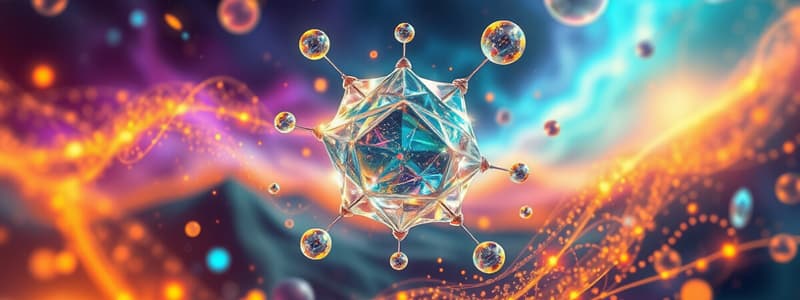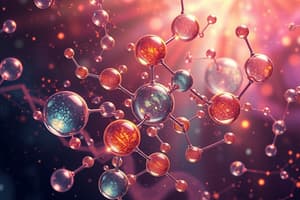Podcast
Questions and Answers
______ is an example of an element.
______ is an example of an element.
Carbon
What are the four most common elements found in living things?
What are the four most common elements found in living things?
carbon, oxygen, nitrogen, and hydrogen
Which of the following elements, essential to life, is a trace element?
Which of the following elements, essential to life, is a trace element?
- Carbon
- Hydrogen
- Oxygen
- Iodine (correct)
An atom with a positive charge has ______.
An atom with a positive charge has ______.
An atom's ______ are found in its nucleus.
An atom's ______ are found in its nucleus.
All atoms of an element have the same number of ______.
All atoms of an element have the same number of ______.
Isotopes of an element have the same number of ______ and different numbers of ______.
Isotopes of an element have the same number of ______ and different numbers of ______.
The bond between oppositely charged ions is a(n) ______ bond.
The bond between oppositely charged ions is a(n) ______ bond.
In the following reaction, what type of bond is holding the two atoms together?
In the following reaction, what type of bond is holding the two atoms together?
The tendency of molecules of the same kind to stick together is called ______.
The tendency of molecules of the same kind to stick together is called ______.
Sugar dissolves when stirred into water. The sugar is the ______, the water is the ______, and the sweetened water is the ______.
Sugar dissolves when stirred into water. The sugar is the ______, the water is the ______, and the sweetened water is the ______.
What does a base do?
What does a base do?
Flashcards are hidden until you start studying
Study Notes
Elements in Living Organisms
- Carbon is an example of a fundamental element.
- Four most common elements in living organisms: carbon, oxygen, nitrogen, and hydrogen.
Trace Elements
- Iodine is a trace element essential for life.
Atomic Structure
- An atom with a positive charge has more protons than electrons.
- Neutrons and protons are located in the nucleus of an atom.
- All atoms of a specific element possess an identical number of protons.
Isotopes
- Isotopes of an element share the same number of protons but differ in the number of neutrons.
Ion Bonds
- Ionic bonds are formed between oppositely charged ions.
- Ionic bonds hold two atoms together in certain chemical reactions.
Molecular Properties
- Cohesion describes the tendency of molecules of the same substance to adhere to each other.
Solutions and Mixtures
- In a solution: sugar acts as the solute, water serves as the solvent, and the resulting sweetened water is the solution.
Characteristics of Bases
- A base is characterized by its ability to remove hydrogen ions (H⁺) from a solution.
Studying That Suits You
Use AI to generate personalized quizzes and flashcards to suit your learning preferences.




